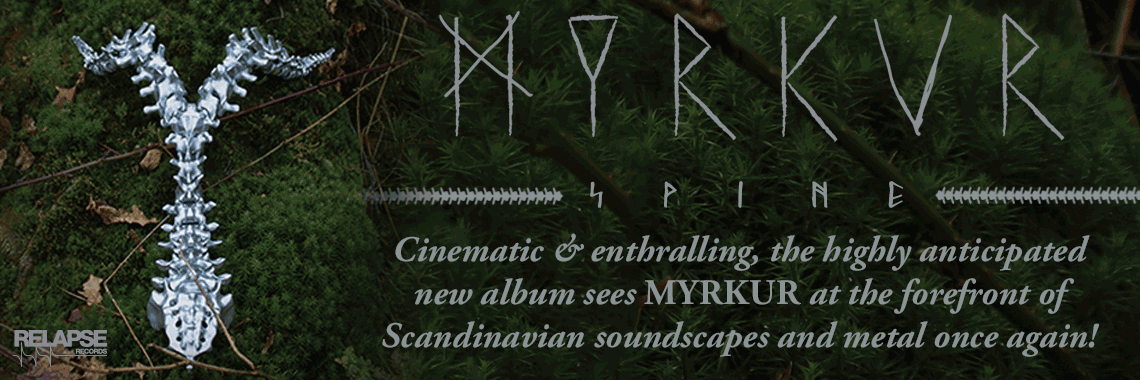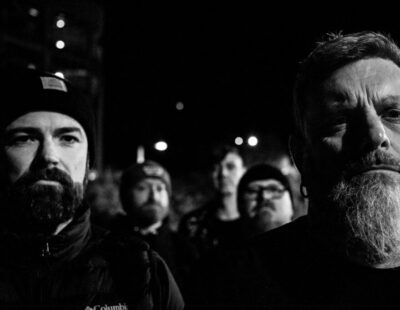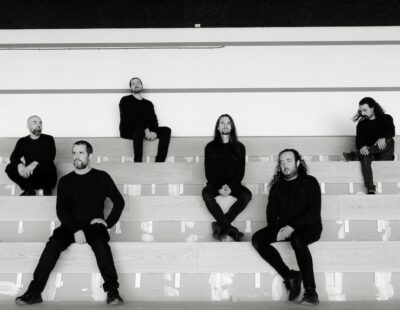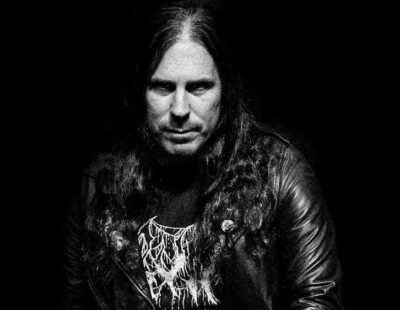
Satanism has been used as an edgy selling point in metal since day one, yet few in the scene have appeared genuine when it comes to espousing their left-hand path beliefs. Nefarious French extreme metal label Norma Evangelium Diaboli, however, houses a small handful of artists with sincere ties to philosophical, occult and esoteric teachings. Releasing albums from Deathspell Omega, Antaeus, Funeral Mist, Rebirth of Nefast, Misþyrming and the subject of this feature, Drastus, NoEvDia’s raison d’être for the past two decades has been to present exceptional underground artists who share similar erudite conceptual principles and shadowy musical visions.
“Out of the primordial fascination for the dark… Satanism is, in the first place, a defiance, a rebellion against dogmas and sheep instinct,” muses the unnamed mastermind behind Drastus when asked what Satanism means to him. “That’s why Satan is the accuser, and I stand beside him. I see the serpent of the myth of Eden as the magical agent, the divider. I consider subterranean forces and sexual energies as the vital force. A beast emanating from the chaos that rages; a beast with whom you shall work to develop yourself, become what you truly are and hold high the torch of Lucifer. These energies are not for the many but for the one; the night is solitary.”
From that very specific (and dramatic) insight it appears that when it comes to Drastus’ powerful death-metal-infused black metal—best conveyed on 2019’s La Croix De Sang—Satanism stands as the utmost source of inner strength for the music, the lyrics and the person behind it all.
Musically, a lot of black metal relies way too heavily on eerie ambient gestures to conjure the aura synonymous with this grim subgenre. Yet what’s impressive about the latest Drastus album, the band’s first release in 10 years, is how that atmosphere is naturally there without the need to rely on disturbing embellishments to create it. It’s in the punishing, cyclic riff torrents, the juddering rhythmic syncopations, and the impassioned screams and seldom-used gothic lamentations. There is a coldness to it, similar to industrial music, that just overwhelms instantaneously.
“That’s the main part of the work and the most interesting, I think,” begins the Drastus multi-instrumentalist, “giving density to the music, the emotions. Your music must already be effective with an unplugged guitar, in my opinion; that’s often how I start, actually. If it’s already dark and violent that way, then when you [electrify it], adding two lines of guitar, a bass, the drums… it all gets very aggressive and furious.
“When your look, your gestures, are more important than the music itself, that’s just show-business to me and pretty far from Drastus’ considerations,” he continues. “You can pour [on] liters of blood and pile up tons of goat skulls, it will never replace what you really need to make true art: balls and interior madness. Look at Van Gogh’s Sunflowers, for example; the tormented nature of the painter is in the execution, not in the subject (sunflowers). You can paint thousands of nuns with crucifixes in their pussies without reaching a hundredth of Van Gogh’s dark madness. The music must hold it all—the music must be the spell.”
Drastus therefore strictly eschew gimmickry in favor of gritty urbanity and genuine darkness when it comes to the presentation of the music—palpably felt throughout La Croix De Sang; but also across Gallic black metal in general, despite its often convoluted themes.
“[You] need to have that darkness in you or it’s pointless, vain, and you should go play some fucking “post-BM,” like all those miserable sons of bitches,” spits Drastus’ main-man. “French BM’s non-uniformity makes it special and we deal differently with the obscure, I think. [French BM] must have a dirty resonance in reality. There is more Satan in French literature than in all the occult books of the world.”
That so-called “dirty resonance” reverberates like a bestial death-rattle captured on this intense record, from beginning to end and with very little in the way of respite from the onslaught. The aphotic dynamism conveyed really feels from the gut rather than the brain; it’s a display of pure primeval force. Where does this energy come from? The initial response is very simple: It’s in Drastus’ nature.
“Drastus is hostile; infernal waters are flowing underneath—that’s where the energy comes from. Art in general suffers too much intellectualization. Art must smell of the cyprine more than the cerebrospinal, that’s how prime waters smell—sperm and blood. The intensity on La Croix De Sang is just the reflection of [the] infernal in these waters.”
Outside of the spiritual, Drastus draw upon elemental forces, primarily fire and the aforementioned water. Neurosis and many black/death metal acts also lean heavily on such symbolism to convey power and/or purification. Drastus state that when you try to reach the primal through art, devoid of all superficiality, that you regress to elemental sources, which in turn leads you right back to “[the] Purificator, the Revelator, the one that burns but doesn’t consume, the Illuminator”—or whatever fiery totem you want to cast around the horned skull of Lucifer.
There doesn’t seem to be the level of knotted theological threads running through La Croix De Sang which can be found in the work of some of Drastus’ NoEvDia label-mates such as Deathspell Omega, though. Instead, the lyrics appear like broad proclamations of occultic imagery. For example, take the conceptual dualities of “Nihil Sine Polum:” “Dissolve the full!/ Coagulate the empty! / Procreate the infernal fire from the sacred soil of division. A seed hatches… solvet saeclum in favilla / venom of God!” Or the poetic nihilism and transcendentalism of “The Crown of Death:” “Every echo of the black rain on the ground of servitude / Made me deaf to the cries of a world that isn’t mine / As I die for and by incandescence / I leave that sphere behind. Clean the clay from the pure bone / And rejoice in the black divine.”
“I write my lyrics the same way I compose my music: with big brushstrokes,” Drastus confirm. “The lyrics on La Croix De Sang were made to work like symbols, to ‘print’ visions. They were not specially made to be understandable; I don’t want to convince anyone of anything. About the work of my ‘labelmates:’ Don’t you think there’s enough assholes out there who are desperately trying to walk in footprints bigger than theirs, aping DsO? By definition, if you follow, you’re late. I don’t follow; it’s not in my nature. I work my art, that’s all.”
Despite being quite guarded about fully revealing the themes at play and how they relate to the author, we are told that “Ashura” speaks of “the existentialism of death,” “Crawling Fire” is about the mutating nature of Satanic fire as vital energy working in Man (“[F]rom the heart of Amon to the scales of Apophis, wherever… When you recognize the Devil, he is already somewhere else”), while “Occissor” is about destroying the “god-self,” your “Adamite part; the assassination of Abel.”
During the lengthy gap between 2005’s Serpent’s Chalice – Materia Prima EP and the masterful La Croix De Sang, the sole composer behind Drastus tells us that, from a personal perspective, he regressed closer to his true self because of dark times and that this has made his beliefs and art more dense and profound over the last few years, and the extended gestation period really benefitted the album—musically and lyrically—in the end.
“I like to think that to compose I have to go down into the abyss, where the causal and the acausal meet,” he reveals in closing. “But yes, that lengthy time period has been essential for some tracks to get to their true essence, for common rocks to turn to black diamonds.”






